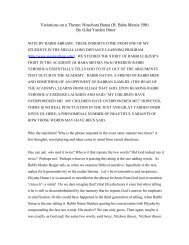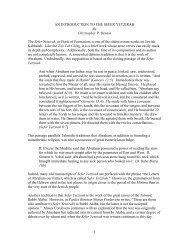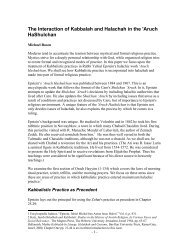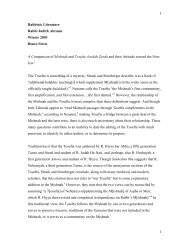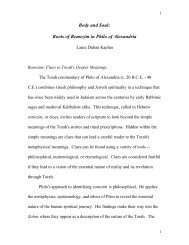The Symbolic Representation of the Sefer Torah - Maqom
The Symbolic Representation of the Sefer Torah - Maqom
The Symbolic Representation of the Sefer Torah - Maqom
Create successful ePaper yourself
Turn your PDF publications into a flip-book with our unique Google optimized e-Paper software.
important is that it was placed with <strong>the</strong> tablets (or broken tablets) containing <strong>the</strong> Ten Commandments thatwas <strong>the</strong> word <strong>of</strong> G-d. Placing <strong>the</strong> <strong>Sefer</strong> <strong>Torah</strong> alongside <strong>the</strong> Ten Commandments meant that its level <strong>of</strong>sacredness was parallel to that <strong>of</strong> <strong>the</strong> Ark <strong>of</strong> <strong>the</strong> Covenant and its contents. Thus <strong>the</strong> <strong>Sefer</strong> <strong>Torah</strong> written byMoses, according to <strong>the</strong> word <strong>of</strong> G-d and possessing <strong>the</strong> sacredness <strong>of</strong> <strong>the</strong> Decalogue, would retain thisholy status in <strong>the</strong> collective memory <strong>of</strong> <strong>the</strong> Jew even after <strong>the</strong> destruction <strong>of</strong> <strong>the</strong> Temple and <strong>the</strong> loss <strong>of</strong> <strong>the</strong>Ark <strong>of</strong> <strong>the</strong> Covenant.<strong>The</strong> Sacredness <strong>of</strong> <strong>the</strong> <strong>Sefer</strong> <strong>Torah</strong>Van der Toorn argues in his essay (1997, pp 229-248) that, since <strong>the</strong> Israelites did not worship idolsand could not use physical entities to represent <strong>the</strong>ir deity, <strong>the</strong>y required a substitute image or icon toidentify with and symbolically represent sacredness. 9 <strong>The</strong> pagans carried idols on <strong>the</strong>ir persons, just as <strong>the</strong>Israelites carried portions <strong>of</strong> <strong>the</strong> <strong>Torah</strong> as represented in phylacteries that contain parchments with <strong>Torah</strong>passages written upon <strong>the</strong>m. Pagan households (as found among <strong>the</strong> Babylonians) had figurines todissuade demons and dangers from entering <strong>the</strong>ir homes, while <strong>the</strong> Israelites placed mezzuzoth containingwords from <strong>the</strong> Scripture on <strong>the</strong>ir doorposts. As an alternative to <strong>the</strong> shrine housing <strong>the</strong> images <strong>of</strong> <strong>the</strong>pagan deity, <strong>the</strong> Cohen or <strong>the</strong> Israelite priest carried an ark containing a <strong>Torah</strong> attributed to <strong>the</strong> pen <strong>of</strong>Moses.On page 234, Van Der Toorn reminds his readers that, although silent, those replicas <strong>of</strong> cult imageshad <strong>the</strong>ir own way <strong>of</strong> speaking to convey <strong>the</strong>ir message. <strong>The</strong>se smaller images not only retained <strong>the</strong>memory <strong>of</strong> <strong>the</strong> real living object but also stimulated <strong>the</strong> devotion <strong>of</strong> <strong>the</strong> believer. Even for those who didnot conceive <strong>of</strong> <strong>the</strong> Deity as a physical entity, and for whom any visual representation <strong>of</strong> <strong>the</strong> Lord wascondemned and forbidden, <strong>the</strong> image <strong>of</strong> <strong>the</strong> <strong>Sefer</strong> <strong>Torah</strong> ( though not <strong>of</strong> <strong>the</strong> Deity) was <strong>the</strong> expression <strong>of</strong><strong>the</strong> divine and <strong>the</strong> manifestation <strong>of</strong> <strong>the</strong> sacred. <strong>The</strong> Israelites were <strong>the</strong> people <strong>of</strong> <strong>the</strong> <strong>Torah</strong> and, from apsychological perspective, <strong>the</strong> <strong>Torah</strong> replaced <strong>the</strong> void with <strong>the</strong> image needed. <strong>The</strong> <strong>Torah</strong> thus served a9 See also Hendel 1997, pp. 205-228.4



